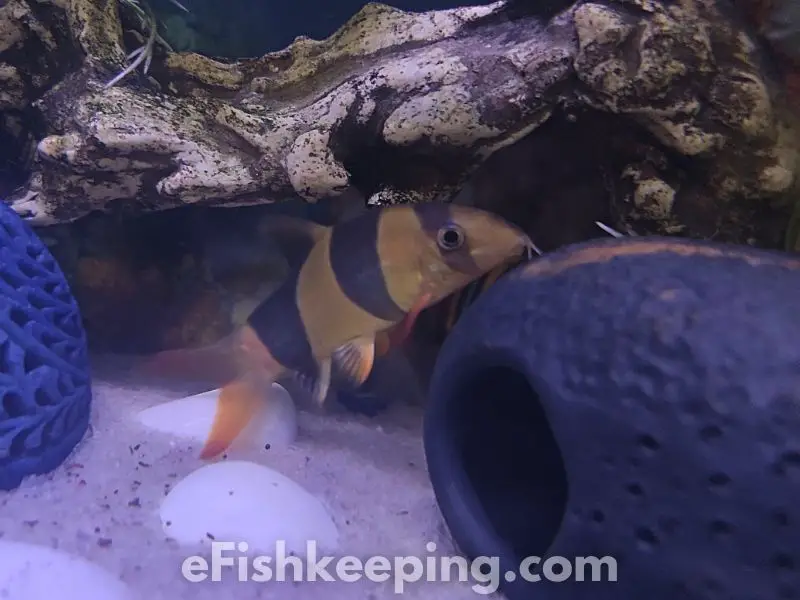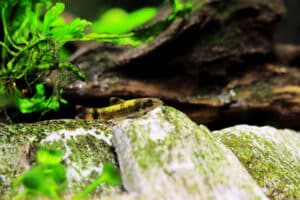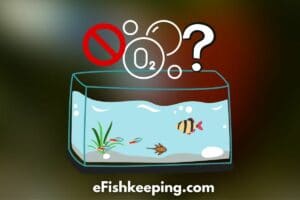Is your clown loach often swimming to the top part of your tank? Then don’t worry because you are exactly in the right place!
I have been keeping clown loaches in my fish tanks for quite some time now. And in this complete guide, I will clear all your confusion and doubts!
Why Is My Clown Loach Swimming At The Top Of The Tank?
The most likely reason your clown loach is swimming at the top of the tank is low oxygen levels in your tank. However, there can also be other reasons like swim bladder disease, poor water parameters, sickness, or this behavior can also be considered normal if they are doing it only sometimes.
Let’s, one by one, discuss all the reasons why clown loaches come to the top of the tank, along with possible solutions.
Reason #1. Normal Behavior

Generally, clown loaches are bottom-dwellers, but sometimes they may also come to the surface searching for food and making their typical clicking sound. So if you are noticing it only seldom, then no need to panic!
Even my clown loaches often come to the surface when it is feeding time. And they make those typical clown loach clicking sound. Most likely they are foraging and looking for some traped foods between the glass surface and the driftwood or anywhere else.
I have two clown loaches in my relatively big parrot cichlid tank. I often find them resting somewhere beneath the driftwood or near the rock.
I mainly notice them when it’s time for feeding. Even after everyone has eaten food, the clown loaches still keep foraging in the entire tank, top to bottom, making their funny clicking sound. Then, after a few hours, they again seem to go out of sight and possibly go to their resting hubs.
Solution: If you only notice the clown loaches coming up to the top (for example, during the feeding time), then it’s okay. Nothing needs to be done on your part. Just relax ad enjoy their behavior!
Related: Can Clown Loaches Eat Algae? Do They Clean The Tank?
Reason #2. Gasping For Oxygen
Now, if your clown loach is constantly near the tank’s surface and gasping, then it can be because of the low oxygen levels in the tank.
It is important to note that fish breathe dissolved oxygen (and not the oxygen integrated into the H2O molecule).
So, when the oxygen level in the tank reduces, your clown loaches would tend to move towards the top portion of the tank. Why? Well, by nature, the level of dissolved oxygen is more towards the top surface of the tank because that is where the air and water interaction occurs.
Therefore, your clown loach will try to move near the top surface of the tank for ease of breathing!
Solution: Check if you have enough aeration going on in your tank. Is your air stone working correctly? (Airstone is a device used in the tank that produces bubbles and helps in surface agitation, leading to better oxygenation in the tank).
Also, keep an eye on the water temperature of your tank. Remember, the higher the water temperature, the lesser the dissolved oxygen will be in your tank. Why? Because the solubility of oxygen reduces with the increase in water temperature.
You can run the air pump and its connected device like airstones all the time to ensure proper oxygenation in the tank.
Reason #3. Suffering From Swim Bladder Disorder
Observe your clown loach, especially the swimming patterns. Is it struggling to swim correctly? Maybe it is swimming upside down? Then most probably, your clown loach is suffering from a swim bladder problem.
Did your fish gulp a lot of air while feeding? Then it could also be the reason why it is floating to the top of the tank.
The swim bladder disorder is a condition in which the swim bladder of a fish doesn’t work properly. This disorder is most commonly seen in goldfish or bettas. But it can occur in almost any fish species.
A swim-bladder is a gas-filled internal organ of a fish that helps to maintain the required buoyancy. A swim bladder disorder can occur due to various reasons like rapid eating, overeating, enlargement in other abdominal organs affecting the swim bladder, parasites and infections affecting the swim bladder, etc.
Don’t panic too much because you can often treat this disorder, and luckily you can also recover your fish fully!
Solution: If you notice the signs of swim bladder disorder, here’s what you can do to treat your fish:
- Start fish fasting! Did you notice an enlarged stomach of your clown loach? Then the first step you can take is not to feed your fish for roughly three days. I recommend you to check out my detailed guide on fish fasting here.
- Reduced water temperature can result in a slower digestive process. This can further cause the enlargement of the gastrointestinal tract and affect the swim bladder as a result. So while treating your clown loach, try to increase the water temperature (to about 78-80 degrees F) and leave it there during the treatment period.
- Now, this is the essential step. On the fourth day, feed your clown loaches cooked and skinned pea. As a general rule of thumb, you can provide your clown loach a pea a day for some days, and then you can revert to fish’s regular diet. But don’t use floating pellets or flakes.
- If you think that your clown loach is suffering from a particular infection that is likely the cause of the swim bladder, then you can also use a broad-spectrum antibiotic for treatment. (You may have to consult a veterinarian in such a case.)
Reason #4. Water Parameters Are Not Ideal

Poor water quality can also be a reason why your clown loaches are hanging near the top of the tank.
Any problem associated with ammonia level, nitrites or nitrates, or incorrect hardness, pH levels, and salinity can cause difficulty breathing in your fish.
When there is a high ammonia level in your tank, the fish will tend to produce more mucus. This will actually reduce the working potential of the gills, and as a result, your fish will struggle intaking oxygen.
See Related: How Long Can Fish Live Without Oxygen?
Furthermore, nitrites can cause changes in the hemoglobin of the fish, which in turn causes your fish to gasp for more oxygen.
Solution: Do a water test to get the right idea of water parameters.
Consider doing about 50% water change and solve any problems with your filter.
You can use a product like Seachem Prime. It removes chlorine and chloramine and also detoxifies ammonia, nitrite, and nitrate. And the good thing is it is a non-acidic substance, so it won’t affect your pH.
I have written a detailed guide on seachem prime. You can check that out for further information.
Reason #5. Suffering From Health Problems
Have you checked all the above-stated reasons but none of them resonates with your case? But still, you are not sure why your clown loach is in the top of the tank? Then hold on, it is most likely because the clown loach fish is sick and suffering from health issues.
Your clown loach can be susceptible to ich or white spot disease. Here are some of the signs of ich:
- presence of small white spots across the body and the gills (that look like a sprinkle of salt grains)
- unusual hiding behavior
- scraping body against objects in the environment
- loss of appetite
Another disease your clown loach fish may encounter is “skinny disease.” Here are some symptoms of this disease:
- Constant Loss of weight (despite how much food your clown loach eats)
- A physical characteristic known as “knifeback” can be observed.
This sickness mainly occurs because of an intestinal parasite known as spironucleus. If you find that your clown loach is eating and behaving normally, but still losing weight, then this parasite is most likely the cause.
Solution: First, identify the type of disease your clown loach is suffering from and then treat it accordingly.
Ich Treatment for clown loach:
- Gradually raise the temperature (between 85F and 90F) for up to seven to ten days. Avoid sudden water temperature changes as they can cause more bad effects than any good.
- Add salt to the aquarium (in general, for every 5 gallons, use about 4-5 tablespoons).
- Do massive water change (almost up to 70%) every other day to remove the ich swimming in your tank water. Your clown loach may be sensitive to large water change; however, they would be glad for the water change to have the ich removed sooner.
- This treatment should work because the ich parasites are not fond of high temperature or salt water. So they should start falling off from the fish.
Note: Avoid using dye-based medicines or the normal copper because our clown loaches don’t have scales. The medications can irritate and lead to the formation of a mucus layer on their body, and they may suffocate.
To know more about how to get rid of ich, I highly recommend you to watch this video:
Now coming to the skinny disease in clown loach, you can use any Levamisole-based treatment to cure it. But, as a precaution, you should also avoid buying any shop specimen that looks starved.
Final Thoughts
In short, if your clown loach moves to the top of the tank only sometimes, then there is nothing to worry about. However, if you notice the clown loach at the top very often, it could be because of swim bladder disorder, lower oxygen level, poor water parameter, or any other illness.
I have already shared a detailed guide about all the reasons and their solution with you. So hope now you can identify the root cause of your clown loach swimming at the top of the tank and solve the problem accordingly.
I wish you all the best and hope your clown loach will soon become normal! Thanks 🙂
Recommended Reading: Are Clown Loaches Aggressive? (Why & How To Stop It!)
Hi! I’m Praveen Ghoshal, the founder of eFishkeeping.com. Inspired by my Dad, I got interested in fishkeeping when I was a kid. Since then, I have been involved with this hobby. Currently, I have 3 fish tanks at our home, and I enjoy this hobby with my full family. Read more about me here.






![Do Neon Tetras Die Easily? [Here’s The Truth!] do-neon-tetras-die-easily](https://efishkeeping.com/wp-content/uploads/2023/03/do-neon-tetras-die-easily-300x200.jpg)
